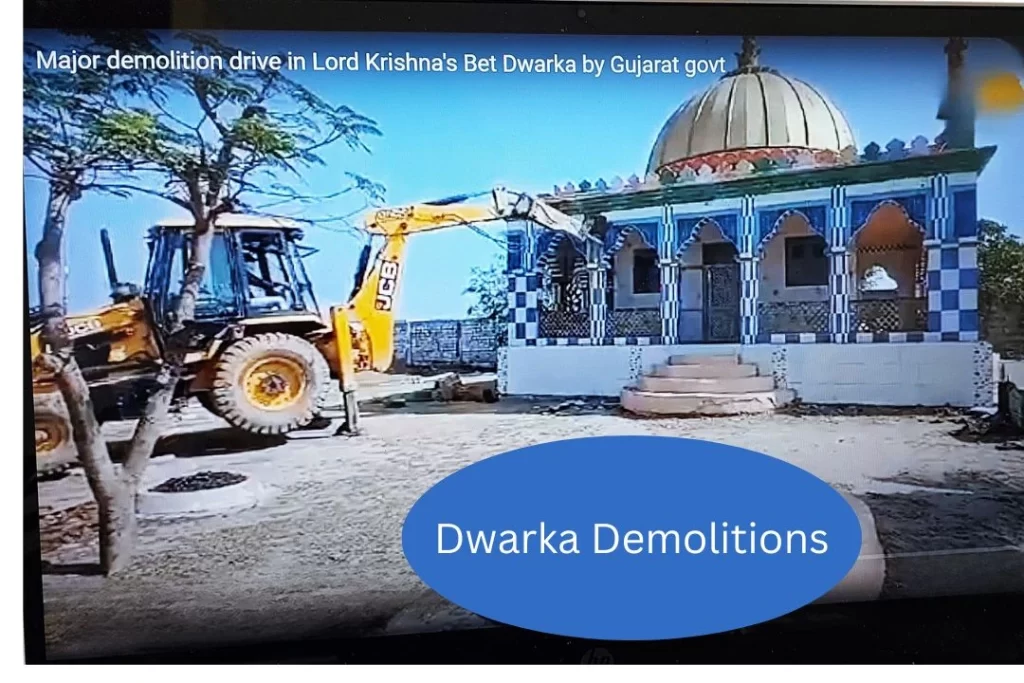In a significant move, authorities in Gujarat have initiated large-scale demolitions in Bet Dwarka, a revered island town associated with Lord Krishna. The operation, reportedly aimed at removing encroachments and unauthorized constructions, has led to the demolition of several structures, including religious sites, residential buildings, and commercial establishments.
The demolition drive, conducted by the Gujarat government, has stirred emotions among locals, religious leaders, and heritage conservationists, who view Bet Dwarka as a sacred land deeply embedded in Hindu mythology. The island, situated off the coast of Okha in the Arabian Sea, is believed to have been Lord Krishna’s residence after he left Mathura and established his kingdom in Dwarka.
Officials have stated that the demolitions are part of a broader plan to restore the historical and ecological integrity of Bet Dwarka. According to the district administration, a significant portion of the island has been encroached upon over the years, with unauthorized structures altering its landscape and obstructing development initiatives.
“The objective is to clear illegal constructions and ensure the preservation of Bet Dwarka’s heritage,” said a senior government official. “We have given prior notices to all occupants and conducted thorough surveys before taking action. The redevelopment plan will include better infrastructure, improved pilgrim facilities, and measures to protect the sanctity of the site.”
The demolition has triggered sharp reactions from religious figures and devotees, who argue that the move disregards the spiritual significance of the island. Bet Dwarka houses several temples, including the revered Dwarkadhish Temple, which is considered an integral part of the Char Dham pilgrimage.
Swami Vishwadevanand, a prominent religious leader, criticized the demolitions, stating, “This is not just about buildings; it’s about faith. The government should ensure that redevelopment efforts do not compromise the island’s religious and cultural essence.”
Social media has also witnessed an outpouring of emotions, with devotees and activists expressing their dismay. Hashtags like #SaveBetDwarka and #ProtectKrishnaDham have trended on various platforms, urging authorities to reconsider their actions.
Bet Dwarka, often referred to as “Shankhodhar” due to its abundant conch shell deposits, is a site of immense historical and archaeological interest. Ancient texts mention that Lord Krishna’s palace was located on the island, and several underwater explorations have suggested the presence of sunken structures that could be remnants of Dwarka’s ancient city.
Archaeologists and historians have raised concerns that large-scale demolitions without careful assessment could lead to the loss of invaluable heritage. “Bet Dwarka is not just another tourist destination; it’s an ancient site with layers of history that need protection,” said a noted archaeologist from Gujarat.
Political leaders have weighed in on the situation, with opposition parties questioning the timing and execution of the demolition drive. Some leaders have accused the government of insensitivity toward religious sentiments and called for a halt to the operation until alternative solutions are discussed.
The government should engage with stakeholders, including temple authorities, historians, and residents, to find a middle ground.”
Meanwhile, the Gujarat government has maintained that the operation is in line with legal protocols and is necessary to prevent further encroachments. Authorities have assured that affected individuals will be provided with alternative arrangements where possible.
Officials have outlined ambitious plans for Bet Dwarka’s transformation. These include the construction of wider roads, improved ferry services, and enhanced pilgrimage amenities. The government also envisions a heritage conservation project that will highlight the island’s historical significance while making it more accessible to visitors.
As the dust settles over the demolished sites, the debate over preserving faith, history, and progress in one of Hinduism’s holiest locations continues to rage.






